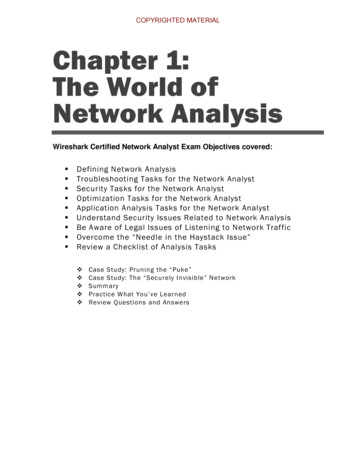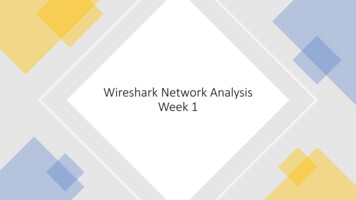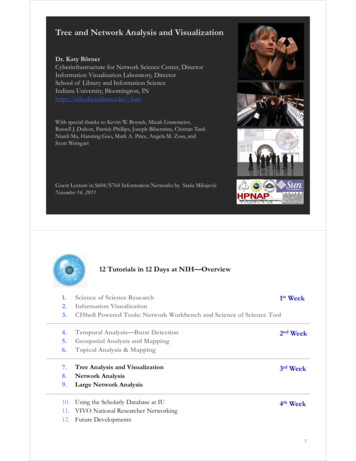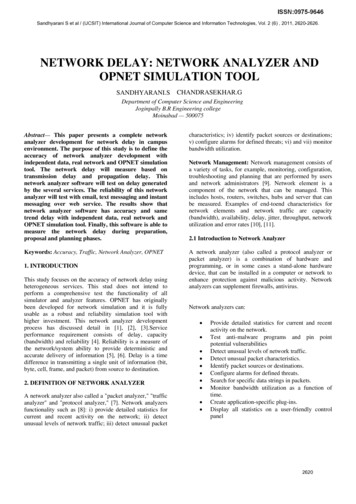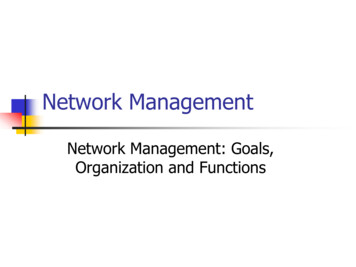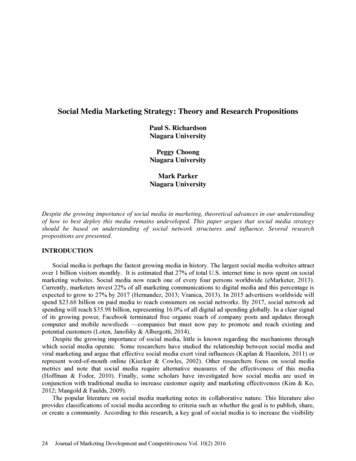
Transcription
sustainabilityArticleApplying Social Network Analysis to Identify ProjectCritical Success FactorsMarco Nunes 1, *12*and António Abreu 2, *Industrial Engineering Department, University of Beira Interior, 6201-001 Covilhã, PortugalMechanical Engineering Department, Polytechnic Institute of Lisbon and CTS Uninova,1959-007 Lisbon, PortugalCorrespondence: marco.nunes@tetrapak.com or D2317@ubi.pt (M.N.); ajfa@dem.isel.ipl.pt (A.A.)Received: 13 January 2020; Accepted: 14 February 2020; Published: 18 February 2020 Abstract: A key challenge in project management is to understand to which extent the dynamicinteractions between the different project people—through formal and informal networks ofcollaboration that temporarily emerge across a project s lifecycle—throughout all the phases ofa project lifecycle, influence a project’s outcome. This challenge has been a growing concern toorganizations that deliver projects, due their huge impact in economic, environmental, and socialsustainability. In this work, a heuristic two-part model, supported with three scientific fields—projectmanagement, risk management, and social network analysis—is proposed, to uncover and measurethe extent to which the dynamic interactions of project people—as they work through networksof collaboration—across all the phases of a project lifecycle, influence a project‘s outcome, by firstidentifying critical success factors regarding five general project collaboration types ((1) communicationand insight, (2) internal and cross collaboration, (3) know-how and power sharing, (4) clustering,and (5) teamwork efficiency) by analyzing delivered projects, and second, using those identified criticalsuccess factors to provide guidance in upcoming projects regarding the five project collaboration types.Keywords: project management; risk management; social network analysis; project outcomelikelihood; project lifecycle; project critical success factors; social capital; people data management;competitive advantage; sustainability1. IntroductionIf organizations want to achieve a sustainable competitive advantage, in today s turbulent andinstable business environment, they need to craft strategies that allow them to boost performanceand innovation [1,2]. Both are strongly influenced by how an organization s core apex guides andmotivates the whole organizational structure in order to overcome some major constraints, such asgeographic barriers, time zones, functions, and cultures [3] Several authors and researchers argue thatperformance and innovation are strongly dependent on the ability of how organizations are able to workin networks of collaboration [4–8]. Research shows that networks of collaboration positively contributeto gaining competitive advantages [4,6], are a powerful source of innovation [9,10]—especially if theyinclude human diversity [11–14], and increase performance if they are efficiently distributed acrossorganizational functions, geographies, and technical expertise domains [15]. Adding to this, latestresearch shows that if organizations want to increase the chances of achieving a sustainable competitiveadvantage, managers should adopt an ambidextrous leadership style [16–19]. This leadership style ischaracterized by exploiting present conditions by optimizing the current business model s operation,and simultaneously, exploring opportunities that help redefine the business model by taking pioneeringrisks. This demands more flexibility, awareness, and insight, and ultimately, working more in networksof collaboration. Indeed, some authors argue that in today s business landscape, although individualSustainability 2020, 12, 1503; ability
Sustainability 2020, 12, 15032 of 32competency and training are important factors, it is almost always the network factor that is the bigkey predictor of high performance in organizations and are usually characterized by having broaderand diverse problem-solving networks fueled with positive energy [20]. But a broader network doesnot necessarily mean larger in size. Furthermore, some authors argue that when it comes to effectivenetworks of collaboration, bigger does not always means better, but rather, superior quality meansbetter [7,8]. However, creating a broad and diverse problem-solving network usually requires anextra mile from the employees of an organization, essentially because they need to be more flexible,accountable, and empowered, and proactively search and maintain such networks. This also meansthat more work will be done through informal networks of relationships, removing to a certain extent,the role of the formal organizational structure in several ways [8,21]. In fact, building a broaderand more diverse problem-solving network requires a proper organizational structure that enablespeople to strategically create the necessary connections in an energized way. Usually, due its rigidnature, a formal organizational structure [6] is not able to provide for the needs of building suchproblem-solving networks [8,22]. However, either under the pressure or when highly motivated to getthe work done, employees of an organization naturally engage in informal networks of collaboration,in order to overcome the natural constraints of the formal organizational structure to get the workdone [8,22,23]. Very often these emerging informal networks are not ruled by the rational-legalauthority system that the formal organizational structure provides based on universalistic principlesthat are understood to be fair, but rather, by fundamentally unfair and particularistic principles, suchas friendship, homophily, propinquity, dependency, trust, and others, which are characterized aspersonal and social needs of individuals [22]. Therefore, if these emerging informal networks—whichare usually hidden behind the organizational formal chart and extremely hard to spot with a nakedeye [23]—are not properly managed, they can turn into an issue and strongly hinder the performanceand innovation capacity of an organization [8,21]. Research shows that organizational informalnetworks have a pervasive influence on employees’ experience of work, being often critical to howthey find information, solve problems, and capitalize on opportunities, and are intimately intertwinedwith employee satisfaction, well-being, and retention [24]. Ultimately, if these informal networksare not properly managed, they can evolve either into a collaborative overload, or lack or inefficientcollaboration patterns [25]. In project environments, the emergence of project informal networks, as anto answer to the day-to-day challenges, occurs at a high speed, and very often is neglected by managers.However, project networks, can be governed and coordinated in very different ways [26]. DavidHillson, a renowned name in the field of project risk management, argues that although the number ofbodies, standards, and institutes that provide guidance in project management is increasing, projectsstill fail at an alarming rate [27,28]. In fact, according to the Standish Group CHAOS report-2015,from 2011 to 2018, only about 29% of executed projects had successful outcomes [29,30], according totraditional project success outcome criteria (time, budget, and scope). The same trend was output by thePMI (Project Management Institute) Institute, in the PMI—Pulse of the Profession 2017 report, whereit shows that from 2011 until 2017, projects on average have been completed on time and on budgetless than 60% of the time, where drivers such as changes in an organization’s priorities, inaccuraterequirements gathering, inadequate or poor communication, and team member procrastination, areamongst the most nominated as being responsible for this outcome [31]. Hillson argues that theunsuccessful projects percentage occurs essentially due three major reasons that directly complywith project risk management [27,32]. First, processes need to be consensually aligned regardingapproaches and risk management standards. Second, principles need to be redefined in order to removesubjective understandings of what risk and project management really is. Finally, people—projectsand risk management are still done by people and not machines. Therefore, people’s different cultures,know-hows, skills, informal interactions, roles, and dynamics need to be deeper researched andless neglected [33]. The people aspect has been highlighted in a publication in 2018 at the HarvardBusiness Review under the name “Better People Analytics,” where two researchers from the peopleanalytics area concluded that, besides the two traditional people analytics factors traits and states,
Sustainability 2020, 12, 15033 of 32a third factor should be considered [34]. This third factor, coined by the researchers as relationaldata, is the mapping and analysis of the employee s informal organizational relationships, in sixdifferent areas. They are: ideation—the prediction of which employees will come up with good ideas;influence—the prediction of which employees will change others’ behavior; efficiency—the prediction ofwhich teams will complete projects on time; innovation—the prediction of which teams will innovateeffectively; silos—the prediction of whether an organization is siloed by measuring its modularity;and network vulnerability—the prediction of which employees the organization cannot afford to lose.Although organizational informal networks should be identified and properly managed, the latestresearch indicates that organizations alone, are not able to do that by themselves, essentially due thenature of the purpose for which organizations are designed, which is to drive operational efficiencies,by managing, coordinating, and controlling activities [6]. The challenge is then, how can we uncoverand properly manage these informal networks of collaboration? The answer can be found on theapplication of social network analysis in organizations. In a nutshell, social network analysis (SNA)is the process of studying social structures, by usually analyzing social dichotomous data with avariety of measures developed based on graph theory that helps to explain how those social structuresevolve trough time, and how they impact the environments where they exist [35,36]. Social networkanalysis theory can play a very important role in bringing light to the social capital challenges [37].Moved by the impact both positive and negative that informal organizational networks may havein an organization’s performance and innovation capacities, researches, institutes and consultingorganizations have been incorporating what some coined as people risk management models into theirtraditional risk management processes [38–40]. At the same time, specialized people risk literature hasbeen outputting latest trends and developments in this area, which includes but is not limited subjectssuch as to talent shortages and retention, incompetence, innovation, working in networks, collectiveand individual performance, cultural fit, values, unethical behavior, low morale, employee wellness,and noncompliance with industry, and fraud [41,42]. In this work, a further contribution to this trendypeople risk field in the area of project management is given, by proposing a heuristic model to identifythe extent to which the dynamic interactions of project people throughout all the phases of a projectlifecycle, influence a project outcome. The proposed model will analyze and quantitatively measurethe project-related information that flows across the naturally emerging project s informal network,throughout all the phases of a project lifecycle. The proposed model is named the project outcomelikelihood model (POL) and was developed based on three scientific fields (Figure 1). They are: projectmanagement theory—which contributes with the terminology used in project management, and thestructure of a project lifecycle; social network analysis theory—which contributes with the tools andtechniques to uncover and measure the dynamic interactions of project people throughout a projectlifecycle; and risk management theory—which contributes with the risk identification and treatmentprocess and framework.
Sustainability 2020, 12, 1503Sustainability 2019, 11, x FOR PEER REVIEW4 of 324 of 32Figure 1. Three scientific pillars that form the basis to the development of the POL model.Figure 1. Three scientific pillars that form the basis to the development of the POL model.2. Literature Review2. Literature Review2.1. History and Evolution of Social Network Analysis2.1. History and Evolution of Social Network AnalysisSince the publication of the book “Who Shall Survive” by the Romanian-American psychiatrist,Since the publication of the book “Who Shall Survive” by the Romanian-American psychiatrist,psychosociologist, and educator Jacob Levy Moreno (1889-1974) in 1934, research and developmentpsychosociologist, and educator Jacob Levy Moreno (1889-1974) in 1934, research and developmentin the field of social network analysis has been exponentially increasing in a wide range ofin the field of social network analysis has been exponentially increasing in a wide range of differentdifferent[43–49].It spanssocialbehavioralsciencesagriculture[51] healthareasareas[43–49].It spanssocialand andbehavioralsciences[50], [50],agriculture[51] healthcare care[52] ationalsafety,safety, criminologycriminology andpoliticalscience[55], mmunication,and nagement andleadership[56],[56],communication,and ldefinedsocialnetworkanalysisas,“Aspecificsetof setand mediajust to name a few. J. Clyde Mitchell defined social network analysis as, “A dditionalpropertythatthecharacteristicsoftheseof linkages among a defined set of persons, with the additional property that the characteristics of theselinkagesas a wholemaybe tousedto interpretthe socialbehaviorthe personsinvolved”[58].linkagesas a wholemay beusedinterpretthe socialbehaviorof the ofpersonsinvolved”[58]. eenaroundformorethantwocenturies,itwaswhenthe application of the graph theory has been around for more than two centuries, it was onlyonly when it started to be applied to study social structures that it exponentially rose in popularity,it started to be applied to study social structures that it exponentially rose in popularity, essentiallyessentially motivated by the desire to understand the extent to which people s behaviors andmotivated by the desire to understand the extent to which people s behaviors and relationshipsrelationships influence others and outcomes, usually translated into performance, innovation, socialinfluenceothersand outcomes,translatedinto ,usuallyand so on[49,59,60]. Indeed,these types ofinnovation,relationships socialare ed,thesetypesofrelationshipsarecomplexbynature,by nature, and cannot be completely explained trough traditional individualistic social theory andand cannotbe completelytraditionalindividualistictheorydata analysisdata analysismethods,explainedbut rathertroughby methodsthat areembedded in socialsociologythatandconsidertheindividual ssocialin theprocessof making inchoices[61]. Itthatis exactlyat thisthat socialsocialmethods,but ratherbycontextmethodsthatare embeddedsociologyconsiderthepointindividual snetworka criticalrole, byprovidingvaluableinsight[61,62].of networkthe very firstcontextin theanalysisprocessplaysof makingchoices[61].It is exactlyat thispointthat ays a critical role, by providing valuable insight [61,62]. One of the very first publications, arguingpublishedin 1979 by socialnetworkresearchersNoelinTichy,Michael L. Tushman,and CharlesFombrunthe benefitsof applyingnetworkanalysisorganizations,was publishedin 1979by network[63]. In their work, they suggested that by applying social network analysis to organizations,researchers Noel Tichy, Michael L. Tushman, and Charles Fombrun [63]. In their work, they suggestedsignificant advances could be made in organizational theory and research, because this approachthat byapplying social network analysis to organizations, significant advances could be made inwould facilitate the comparative analysis of organizations as well as the comparison of subunitsorganizationaland nalysiswithin an ldthe benefitsof theapplyingSNA wereof organizationsas appearedwell as thecomparisonof costs.subunitswithinan organization.Furthermore,substantial andto faroutweigh theIn fact,in a comparativescenariobetween two theyoutlinedthat the benefitsof example,applyingitSNAwere substantialand appearedto far outweighthe costs.organizations,where, foris assumedthat the performanceand innovationlevels of bothareindirectconsequencesof thebetweendynamicsoforganizations,their informal where,networks,whenitthosedynamicsIn fact,a comparativescenariotwofor onlyexample,is assumedthat plyingSNA)canthecomparisonbedone.performance and innovation levels of both are direct consequences of the dynamics of their informalnetworks, only when those dynamics become quantitatively measured (which can be done by applying2.2. Social Network Analysis and Project ManagementSNA) can the comparison be done.
Sustainability 2020, 12, 15035 of 322.2. Social Network Analysis and Project Management2.2.1. Project Management ChallengesA project is a temporary endeavor with a defined beginning and end, designed to create a uniqueproduct or service, and is expected be properly managed by the application of knowledge, skills, tools,and techniques to project activities to meet the project requirements, throughout all the different projectphases that comprise a project lifecycle [64]. Due lack of consensus regarding how many phases aproject should be divided into, a common approach is that the number of project phases is determinedby the project team, and/or the type of the project. Project management challenges, usually calledproject risks (essentially threats, rather than opportunities), represent essentially the likelihood of notdelivering planned project activities within the constraints (usually, scope, quality, schedule, costs,and resources [64]) associated to a project. According to David Hillson, project risk is the uncertaintythat matters [65] and aims to separate what a real project risk is, from what a not real project risk is.Hillson suggests four types of uncertainties that could affect a project’s ability to achieve its objectives,regardless of a project phase [65]. They are: 1—Event risk: Possible future events, sometimes called“stochastic uncertainty” or “event risks.” An event risk is something that has not yet happened andmay not happen at all, but if it does happen, it has an impact on one or more project objectives; most ofthe risk identified at the project risk register is of this type, and a set of well-established techniques foridentifying, assessing, and managing them already exists. 2—Variability risk (also called “aleatoricuncertainty”): They are a set number of possible known outcomes, among which it is not known whichone will really occur. These types of project risks cannot be managed by applying standard risk processprocedures, but rather advanced analysis models, such as the Monte Carlo simulation. 3—Ambiguityrisks (also known as “epistemic uncertainties”): Uncertainties arising from lack of knowledge orunderstanding. Could be called know-how and know-what risks. They comprise the use of newtechnology, market conditions, competitor capability or intentions, and so on. These can be managedby learning from experience of others—lessons learned—and by prototyping and simulating beforetaking real action. The proposed model in this work can be seen as a framework to manage ambiguousrisk types, once it aims to identify critical success factors from past events (lessons learned), and useidentified critical success factors to guide and predict (simulations) a future outcome of an ongoingproject. 4—Emergent risks: They emerge from people s blind-spots. Usually called “ontologicaluncertainty,” they are more commonly known as “black swans.” These risks are unable to be seenbecause they are outside a person s experience or mindset, so one does not know that he shouldbe looking for them at all. Usually they arise from game-changers and paradigm shifters, such asthe release of disruptive inventions or products, or the use of cross-over technology from previouslyunforeseen sources. To manage them, contingency seems to be the key word, sometimes definedas “the capacity to maintain core purpose and integrity in the face of external or internal shock andchange”. Pinto and Slevin, 1988 [66], uncovered a set of ten critical success factors that, contrary toHillson, change importance according to a project phase. These critical success factors are consideredmajor project risks that if not properly managed, will hinder the chances of a success outcome. They are:(1) project mission not being properly defined, (2) lack of top management support, (3) non-detailedproject schedule, (4) poor client consultation, (5) lack of necessary and proper technology and expertise,(6) poor team skills and experience, (7) ambiguous client acceptance, (8) lack of proper monitoringand feedback of project activities, (9) poor or lack of proper communication, and (10) non-readiness tohandle excepted crises and deviations from plan (in other words, lack of a contingency plan). It can besaid that regardless of a project phase, the above-mentioned risks and critical success factors, if notproperly managed, will damage the likelihood of achieving a successful project outcome.2.2.2. Application of Social Network Analysis in Project ManagementThe application of social network analysis has been in the last few years extending into the area ofproject management, although this adoption remains so far at a very initial stage [67,68]. In project
Sustainability 2020, 12, 15036 of 32environment, objectives such, as but not limited to, understanding and measure knowledge transfer,consensus building, and the identification of critical success factors—regarding the dynamics of projectinformal networks—which may contribute to a success project outcome, have been priorities of theapplication of social network analysis [69,70]. Regarding the identification of critical project successfactors though, still without applying social network analysis, it has been a present preoccupationwithin the most recent years. One of the very first notable works regarding the identification of criticalsuccess factors in project management was published by Pinto and Slevin in 1988. By surveying circa400 project managers from very different industries areas, asking them what major reasons that leadto success and unsuccess projects allowed them to identify a set of common critical factors that wereindicated as responsible for a successful project outcome. Furthermore, they identified that thosecritical factors were changing the importance degree, function of the project phase [66]. They identifieda top ten set of critical factors. Three of them are related to how project people work in networks ofcollaboration throughout the different phases of a project lifecycle. They are top management support,client consultation, and communicating network. The findings made by Pinto and Slevin in 1988,were revalidated by research conducted in 2005 and 2012 [71,72]. This study contributed to triggeringthe interest of network and project researchers that soon brought social network analysis into theproject management field. They are trying to provide valuable insight into some of these criticalfactors identified by Pinto and Slevin. In a publication at the Harvard Business Review (HBR) in 1993,professor David Krackhardt, and Jeffrey R. Hanson, highlighted the importance of managers tappingtheir informal organizational networks as being a key contributor for success, essentially by mappingthree types of networks: the advice network—which reveals the people to whom others turn to get workdone; the trust network—which uncovers who shares delicate information; and the communicationnetwork—which shows who talks to whom about work-related matters [8]. These three networkswould then be mapped with the employee s relational information collected through surveys. Theyargued that this approach would get to the roots of many organizational problems. In 2001 StephenMead conducted one of the first, and top ten most-cited case studies ever [73], wherein he appliedsocial network analysis in a project environment to visualize project teams [74]. By the applicationof SNA, Mead identified and analyzed an informal project stakeholder s communication network.Mead identified isolated and central stakeholders regarding the informal communication network andelaborated a corrective plan in order to improve the performances of those that were isolated. In thelatest 30 years, remarkable research has been done by Professor Rob Cross, a renowned researcher anddeveloper who applies social network analysis to study organizations. In one of his works, “The HiddenPower of Social Networks,” published in 2004, he collects a set of ten-year research cases in the study oforganizations, and he highlights the many benefits of the application of SNA in organizations, especiallyin project environments [23]. Cross found that in every organization, there is an informal organizationalnetwork that is responsible for how the work is done. Furthermore, he argues that in every informalorganizational network, there are a set of common actors who are responsible for most dynamics ofan organization. These actors include: the central connector, the boundary spanner, the informationbroker, the peripheral expert, the peripheral intentional, and the energizer. These names were coinedto functionally describe their positions in the informal network structure [21,23]. An application ofsocial network analysis in the health projects environment is illustrated by a study conducted by theU.S. department of health and human services, where SNA methods and measures were appliedto understand the multidimensional determinants and complexity of tobacco use [75]. Prell et al.(2009) applied SNA to analyze stakeholder networks in a natural resource management, where theyidentified which individuals and categories of stakeholder played more central roles in the projectnetwork and which were more peripheral, leading this information to guide stakeholder selection.Another notable work, regarding the application of social network analysis in projects, was publishedin one of the most credited project management institutes [64] in 2012; it details the importance offour key subjects of social network analysis, showing that those key subjects are directly related toproject management performance [76]. They are centrality, structural holes, boundary management,
Sustainability 2020, 12, 15037 of 32and tie strength. The other latest studies regarding the application of social network analysis inproject environments, go from the development of models based on SNA to analyze communication,collaboration, and knowledge networks in project meta-networks [77], to the analysis of mega projectsnetworks, from the perspectives of different important project stakeholders that help to develop properlong-term project governance policies [78,79]. In 2017, Mok et al. (2017) [80] applied SNA basicnetwork centrality measures to identify key challenges in major engineering projects (MEPs) basedon interdependencies between stakeholder concerns, resulting in the identification of a set of keychallenges that that occur in such MEPs, and helped to properly develop a set of recommendations toalleviate those challenges, which could be used in future MEPs. Yu et al. (2017) [81], used social networkanalysis to investigate social risks related to housing demolition, from a stakeholder perspective inChina. A recent work in the field of organizations, developed by Michael Arena, Chief Talent Officerfor General Motors, concluded that, after years of investigation in several organizations, successfulorganizations operate in a networked way, enjoying what they called an adaptative space, which enablesa proper connection between the operational and entrepreneurial pockets of an organization in a virtualspace—adaptative space—where employees explore new ideas, and empower the most creative peopleto spread their ideas across the organization. This adaptative space is built, managed, and maintainedusing social network analysis [6]. Arena argues that this adaptative space enables organizations to workin a more agile way, which ultimately contributes to outperforming the competition in a disruptive way.However, research and development in the area of SNA extends to other areas, as does the example ofthe research done by professor Eric Xing, where he conducted an investigation on dynamic predictivemodels, built on social network analysis theory, which have as objectives, forecasting how people willinteract and react when facing different future events [82]. Such predictive models, integrated intothe risk management process of an organization, may strongly help organizations to better, and moreaccurately prepare projects or operations, by estimating with a higher certainty degree the evolutionof future events, and thus, prepare proper plans to respond t
sustainability Article Applying Social Network Analysis to Identify Project Critical Success Factors Marco Nunes 1,* and António Abreu 2,* 1 Industrial Engineering Department, University of Beira Interior, 6201-001 Covilhã, Portugal 2 Mechanical Engineering Department, Polytechnic Institute of Lisbon and CTS Uninova, 1959-007 Lisbon, Portugal * Correspondence: marco.nunes@tetrapak.com or .
